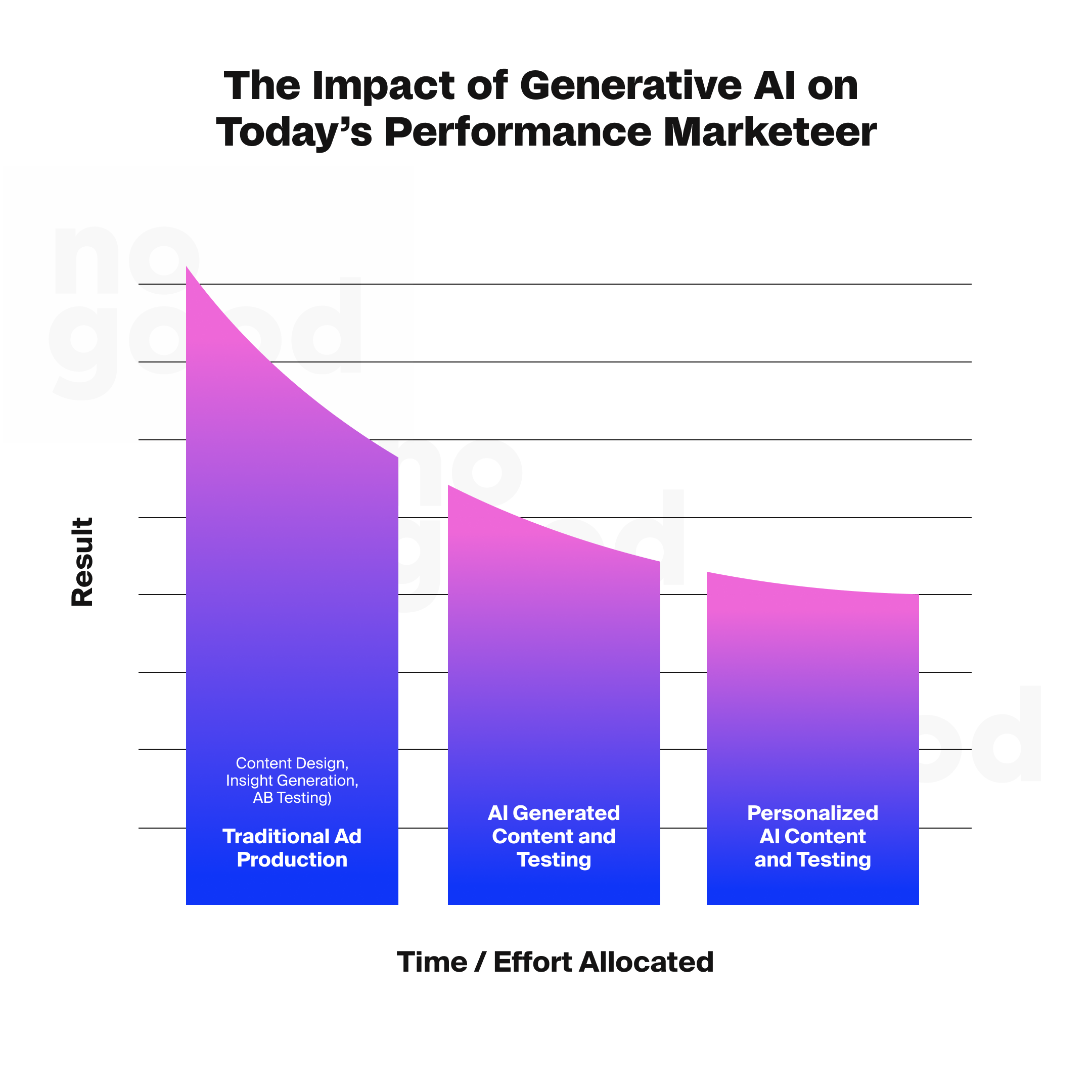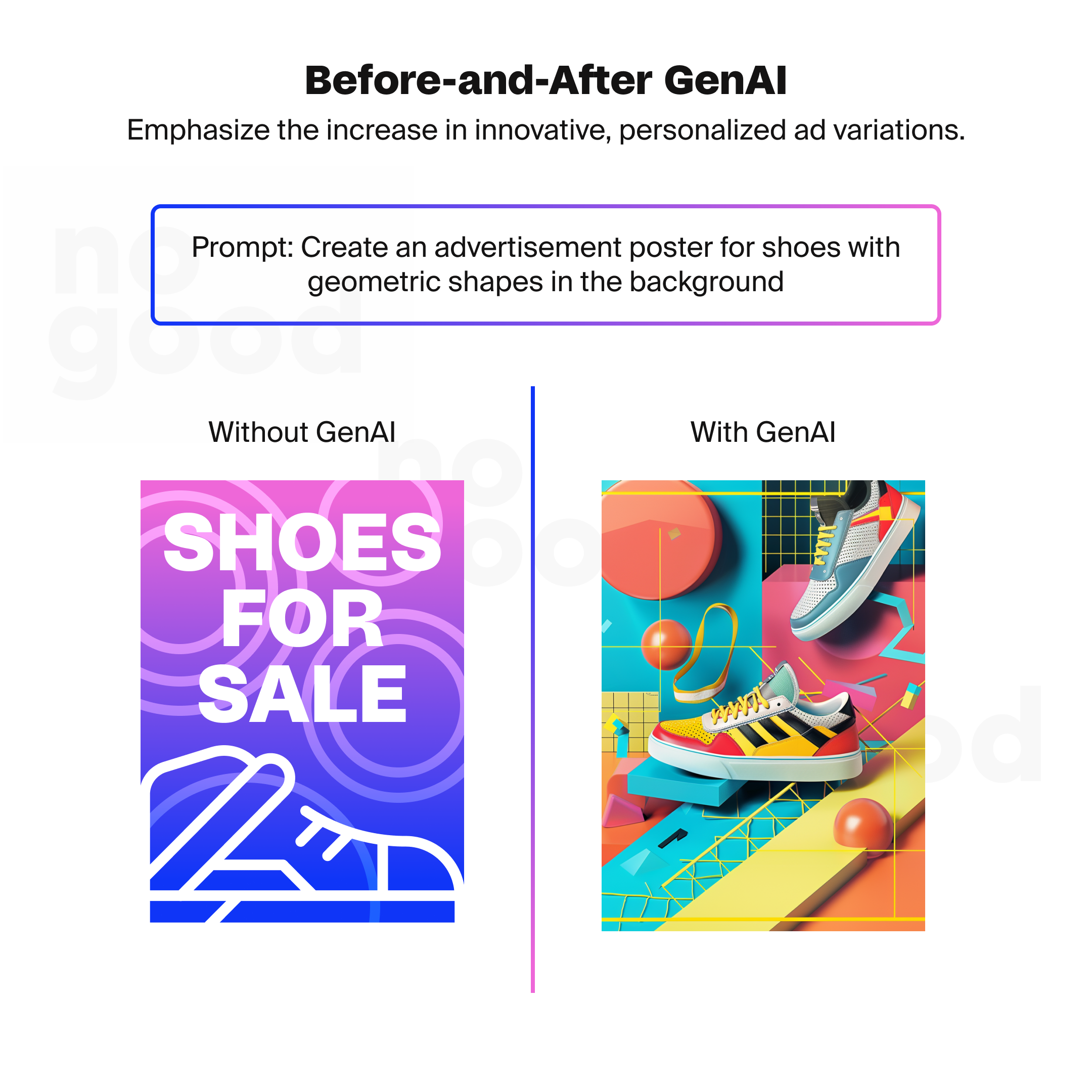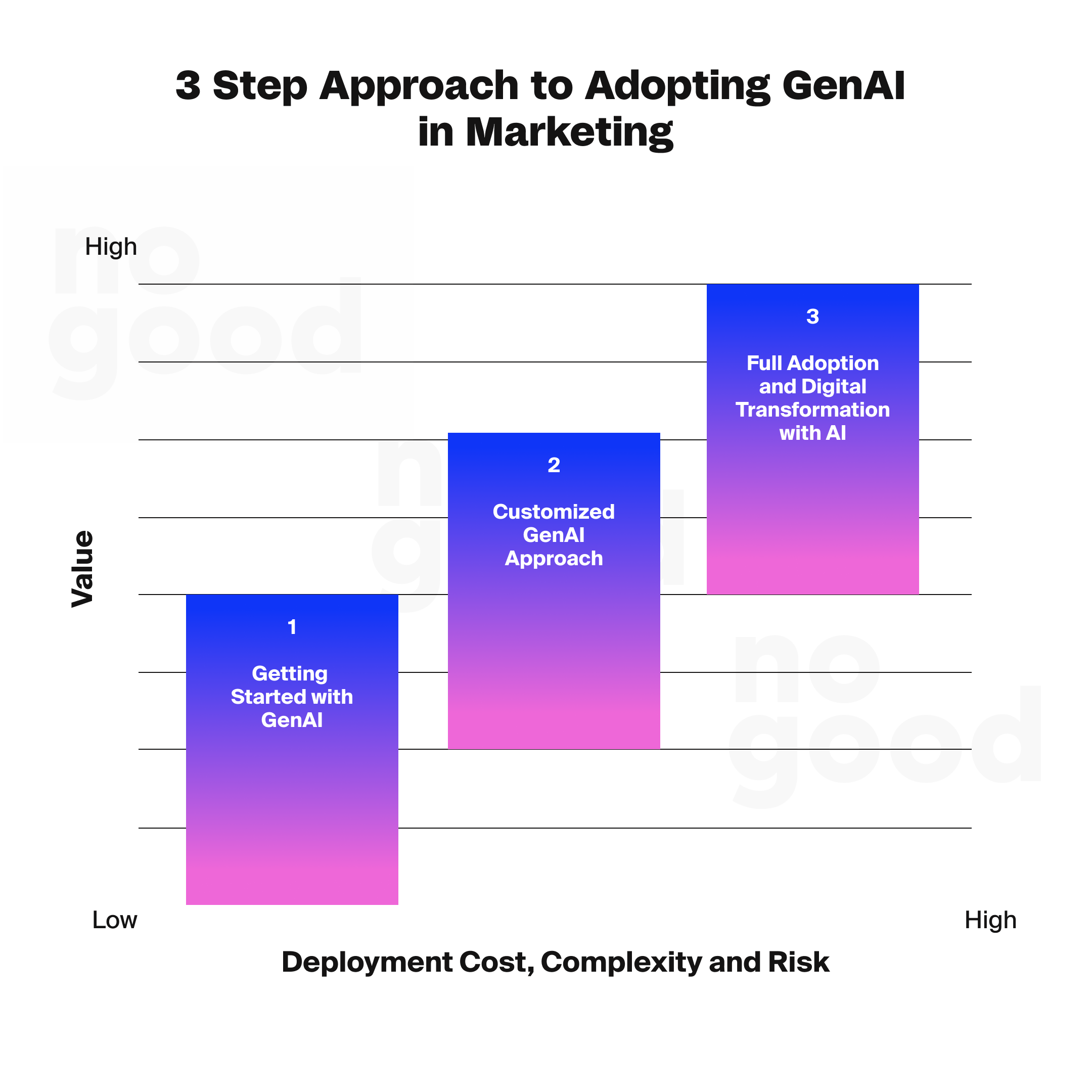Reaching the right audience at the right time on the right channel and most importantly with the right messaging and creative has always been the cornerstone of digital marketing. However the fact of the matter is that due to the number of variables at play, marketers are drowning in the sheer amount of campaign optimizations as well as content they need to create in order to keep up with different tactical executions.
Here’s what we’ll cover:
- The Impact of Generative AI on Today’s Performance Marketeer
- Achieving Hyper-Personalization at Scale with Generative AI
- The Way Forward – Adopting Generative AI in Marketing Processes
The Impact of Generative AI on Today’s Performance Marketeer
With artificial intelligence and machine learning continuing to push the boundaries of what is possible across all industries, generative AI (GenAI) undoubtedly stands out as a powerful force in marketing and performance creatives. As marketers seek to captivate audiences with more personalized, innovative, and engaging content, GenAI offers tools and technologies that push the boundaries of creativity and efficiency – tasks that once took months, like content design, insight generation, and user AB testing, are now possible in weeks or even days.
This rapid deployment, combined with at-scale personalization and automated testing with GenAI, heralds a new frontier in digital marketing.

Achieving Hyper-Personalization at Scale with Generative AI
The advent of GenAI has ushered in an era of performance marketers achieving the holy grail of hyper-personalization at scale.
By utilizing vast databases and complex algorithms, GenAI can assist brands with tailored advertising strategies that powerfully connect with individual consumers. This level of personalization goes beyond straightforward segmentation; instead, marketing messaging, targeting, and information can be tailored based on interests, behaviors, and demographics. This customized approach enhances relationships between brands and consumers, making them stronger and more meaningful while also encouraging brand loyalty.
By integrating GenAI into existing workflows at each part of the customer journey, brands are now able to develop personalized marketing strategies from the moment the customer is aware of the brand to acquisition, retention, and upselling – the goal of which is to raise conversion rates and boost the general effectiveness of marketing activities. According to an Artificial Intelligence Global Study, companies reporting ”AI adoption have seen average revenue growth of 15% between 2019 and today – more than double the rate at firms where investment in or use of the technology has stalled over the past four years.”
There are 3 main strategies we see marketing hyper-personalization at scale becoming a reality with GenAI.
1. Persona Segmentation
By leveraging data analytics, machine learning, and AI-generated content, marketers can create highly personalized experiences that resonate deeply with specific customer segments and cohorts across the entire customer journey.
Implementing granular personalization involves several key steps, starting first and foremost with data collection and analysis. As a customer enters their buying journey, GenAI’s advanced algorithms can leverage patterns in customer and market data to segment and target relevant audiences. However, companies should first focus on gathering comprehensive datasets from various touchpoints such as website visits, consumer social media interactions, and purchase history – from there, GenAI can extrapolate demographics, purchasing history, online behavior, and preferences.
While there is so much data that can be collected, putting it into structured formats in order to feed it into your customer channels is currently the missing link. Brands must ensure that the data collected is clean, accurately tagged, and well structured, which will then provide the foundational frameworks that allow AI algorithms to identify distinct audience segments from which to plan and perform granular analyses of consumer behavior. Know Your Customer (KYC) profiles should be the golden mantra in your agenda of this detailed persona segmentation automation journey.
With GenAI’s ability to analyze distinct audience segments, customer behaviors, preferences, and demographics, businesses can then take personalization one step further by leveraging dynamic audience targeting and segmentation with personalized content and messaging in their marketing campaigns. Leveraging predictive analytics from this foundational data, GenAI can craft hyper-personalized email marketing messages at scale that address each recipient by name, reference their past interactions with the brand, and recommend products based on their purchase history.
AI Platforms like Persado have tools like Persado Dynamic Motivation that leverage behavioral segmentation to significantly improve engagement rates and conversion. Brands can use first-party data from their customer data platform (CDP) or analyze their brand’s session data to gain insights into customer’s interests through their purchase history, browsing habits, preferences, and more, enabling the delivery of real-time messages tailored to each individual customer. Customers who require an incentive to shop versus ones who simply need an attractive email with product information are charted into distinguishable segments.
The platform is able to even further segment these customers based on the types of incentives that worked best, such as receiving a 20% off coupon verus those who were more likely to shop if they got Buy-One-Get-One coupons. By utilizing AI in a series of personalized email and text marketing campaigns geared to customer behavior, brands can experience a significant performance boost in engagement rates and conversions.
2. Creative Innovation
Now that key opportunities have been identified with your personalized audience segmentation, idea generation is the next key step in being bold and capitalizing with GenAI. As part of personalization, one of the key benefits of GenAI is the ability to produce innovative creatives and content at scale. By accelerating the processes of content creation and curation, GenAI has completely transformed the landscape of innovative online content.
With the right prompts, AI-powered technologies are now able to own the entire content creation and production process across a wide range of content formats, including text, photos, and videos, with astounding efficiency. In fact, according to a report by Hubspot, marketers can save up to three hours a day on content creation with the help of generative AI. Content curation can also be elevated as GenAI helps to identify the most pertinent and captivating content based on the plethora of specific persona segments as identified in the previous section.
This capability is crucial for expert marketers looking to produce a high volume of novel ideas, creative concepts, and personalized ad variations across various platforms, ensuring each piece is both unique and personalized while meeting their campaign’s predefined objectives.

How marketers can kickstart their workflow is by integrating AI into analyzing their brand’s marketing goals, target audience demographics, and engagement data to suggest creative concepts that are likely to perform well. From there, multiple variations of ad copy, headlines, or visual elements can be generated to test different combinations in order to determine which ones achieve the best results. Beyond text-based and static content, AI can assist with multimedia generation, such as video creation and production. GenAI can draft scripts, produce video animations, and even record realistic voiceovers, generating a complete video that a content team would typically take a few weeks to create.
Synthesia is a great option if you want to boost heavy-lift assets such as videos, but either don’t want to reveal your face, or are lacking resources to put out volume of videos. Synthesia is an AI-powered tool that can facilitate the whole video creation process – simply work from one of their industry-specific templates to quickly build a script with text prompts, Synthesia then takes this video script and turns it into a professional video completed with narration and even an AI-generated human stock/custom avatar. Video voiceovers can even be localized in over 120 languages, including closed captions. From there, brands are able to review and edit their video before publishing, all within the platform.
This is especially important for geographies such as Southeast Asia and Europe, where Go-To-Market strategy typically requires intensive localization to tailor communications to each segment’s region, dialect, currency, and trends, amongst other attributes. With a lean operation, most brands are constrained by its ability to customize content to their macrosegments, not to mention global audiences with their cultural nuances. This typically results in blunt customer messaging that does not resonate with customers, leading to low conversion rates across their digital channels.
Previously time-consuming, highly manual, and costly tasks such as translation and transcription can now be handled by AI tools, not only solving the challenges of scalability and cost but also saving the time for marketers to ensure that the material is relevant to the audience, allowing brands to reach a wider market with better engagement and enhanced brand identification. With the popularity of short-form videos and the continued rise of TikTok and YouTube shorts, Fortune Business Insights predicts the video streaming market will reach $932 billion by 2028, a compound annual growth rate of 12.1%. As a result, businesses looking at global GTM strategies will increasingly need the power of AI-driven localization.
As part of integrating GenAI into the creative workflow and persona segmentation, brands can train existing GenAI models on non-personally identifiable information, including each segment’s demographic, region, dialect, and other attributes, to fine-tune their marketing. This information can then be passed to dynamic content generation tools such as Jasper AI and Dall-E to create copy and imagery, which can then be ported into various marketing channels for deployment. Brands simply need to ensure that there are appropriate guardrails in place by adding a human-in-the-loop step to the process, especially for brands that have strict brand protocols and guidelines.
Ultimately, the shift from manual to AI-driven processes will expedite the potential of creative innovation for performance marketers, leading to enhanced efficiency, quality, creativity, and scalability for brands.
3. Rapid Testing and Real-time Optimization
Now that you’ve used GenAI to embark on specific persona segmentation and developed a wide range of innovative creative concepts, it comes with no surprise that GenAI is also able to facilitate campaign development for rapid testing and real-time optimization at scale.
GenAI platforms can help with the dynamic adjustment of campaign parameters in real-time, analyzing campaign performance and tailoring bidding strategies, target audiences, and ad placements to improve performance on the fly. Layering this with predictive analytics, GenAI tools such as AlbertAI can then forecast future trends based on your historical performance data and current campaign assets, potentially allowing you to allocate budgets more effectively and capitalize on upcoming opportunities before they become apparent to competitors.
Traditional A/B testing can be resource-intensive and slow but with GenAI, digital marketing campaign automation becomes possible, and thousands of variations can be tested simultaneously, allowing you to create a robust feedback loop. This rapid testing leads to quicker data-driven optimization decisions, reducing the time and cost to identify the most effective campaign elements.
For instance, Seventh Sense optimizes your email campaigns in real-time, helping you win attention in your customers’ overcrowded email inboxes by finding the perfect send time and day for each of your email campaigns. Choosing the best day and time to send an email is always a gamble. While some days of the week generally get higher email open rates than others, you’ll never be able to nail down a time that’s best for every customer. GenAI tools like Seventh Sense are able to conduct automated testing and optimization.
Continuously testing different strategies and content with each persona segment to optimize engagement and conversion rates, using AI for real-time adjustments, and ultimately determining the best timing and email frequency for each contact based on when they’re opening emails.
Beyond marketing campaign automation, once your customers know that you know them and their preferences well, it lays a very good foundation for a powerful customer service journey and the retention of your customers with real-time personalization.
With the help of GenAI, brands should aim to elevate their A/B and multivariate testing with Dynamic Interaction, essentially facilitating dynamic interactions with customers the moment they enter their user buying journey. As a consumer moves through the customer buying journey, dynamic customer-journey mapping can be utilized to identify critical touchpoints and drive customer engagement. GenAI can provide data-driven recommendations that enable the dynamic adjustment of your website content, recommendations, and advertisements based on real-time user behavior.
This means that as a user interacts with your website, the content they are presented with adapts to their actions and preferences. Marketing strategies can be further optimized here through AB testing of different elements such as page layouts, ad copy, and SEO strategies, leveraging GenAI to best optimize and test based on evolving customer patterns to ensure your business maximizes return on investment.
Dynamic Yield is an example that provides a robust suite of AI tools to streamline and enhance website optimization through multivariate testing. While every marketer knows that A/B tests are a staple tool, when you’re limited to testing two variables against each other at a time, it typically takes months to get the results marketers are looking for.
Dynamic Yield lets you test all your ideas at once, focusing on learning from user interactions to inform changes that could improve site performance. It uses advanced algorithms to identify the top-performing concepts, combines them, and repeats the process to achieve the best site experience. The platform’s AI capabilities allow for testing and optimization to be baked into every action, allowing you to dynamically restructure any page layout or element according to each visitor’s preferences in real-time once performance is determined.
The end goal of personalizing journeys and not individual touchpoints is to offer customers a good website and Customer Experience (CX) journey to make them feel like the brand cares for them and is approachable throughout their user journey. This approach can lead to incremental improvements that collectively have a significant impact on conversion rates and overall customer satisfaction.
The Way Forward – Adopting Generative AI in Marketing Processes
The role of marketers is evolving with GenAI, offering an innovative path for marketers to engage with consumers like never before. As we explore and implement these technologies, the future of marketing looks not only more efficient but also more creative and personalized, ensuring that the relationship between brands and their audiences grows stronger and more meaningful.
Marketers should look to harness AI as their superpower through a 3-step approach.

Level 1: Getting Started with Gen AI
- Marketers can implement an entry-level adoption approach, leveraging existing AI tools for quick wins through opportunity identification and idea generation.
- Off-the-shelf AI tools such as automated writing tools for ad copywriting, messaging, and creative ideation provide an easy starting point for brands to test process optimization.
Level 2: Customized Gen AI Approach
- Once familiar, brands can identify a few low-risk, high-impact and low-cost, use cases to experiment with GenAI.
- Brands should use this time to set up processes, implement guardrails for use, and, most importantly, conduct in-depth analysis by setting up data frameworks, tracking results, and refining with the aim for broader implementation.
Level 3: Full Adoption and Digital Transformation with AI
- Brands that have seen success in implementing the foundations of GenAI across their processes should start exploring the transformative potential of full-suite AI capabilities for marketing.
- Provide guidelines for adoption and conduct a full audit of marketing processes and structures to identify use cases for process automation, personalization, and analysis.
- Ensure teams are trained on the fundamentals of GenAI to showcase the future of AI-enabled marketing
The future of GenAI in performance marketing is bright, highlighting a future where marketers are now given not only better capabilities but more time to obsess over their customers again. GenAI provisions brands and marketing teams to genuinely connect with their customers to identify how your products can even better solve their unique needs. While this technology promises to unlock new opportunities for brands to connect with their audiences in meaningful and impactful ways, it also shows that creativity, personalization, and efficiency are paramount in the near future.
As brands begin dipping their toes into the waters of GenAI, it is key for marketers to start better understanding and adopting AI technologies in order to stay competitive






